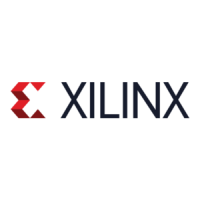Using TXPROGDIVCLK to Drive the TX Interface
Depending on the TXUSRCLK and TXUSRCLK2 frequencies, there are dierent ways UltraScale
architecture clock resources can be used to drive the parallel clock for the TX interface. Figure 26
through Figure 29 show dierent ways clock resources can be used to drive the parallel clocks
for the TX interface.
Depending on the input reference clock frequency and the required line rate, a BUFG_GT with a
properly congured divide seng is required. The UltraScale+ FPGAs GTM Transceivers Wizard
creates a sample design based on dierent design requirements for most cases.
TXPROGDIVCLK Driving GTM Transceiver TX in 64-Bit, 80-Bit, or 128-
Bit Mode
In the following gure, TXPROGDIVCLK is used to drive TXUSRCLK and TXUSRCLK2 in 64-bit,
80-bit, or 128-bit mode in a single-lane conguraon. In all cases, the frequency of TXUSRCLK2
is equal to TXUSRCLK.
Figure 26: Single Lane—TXPROGDIVCLK Drives TXUSRCLK and TXUSRCLK2 (64-Bit, 80-
Bit, or 128-Bit Mode)
Design in UltraScale
Architecture
UltraScale
Devices GTM
Transceiver
TXPROGDIVCLK
BUFG_GT
1
TXUSRCLK2
2
TXUSRCLK
2,3
TXDATA (TX data width = 64/80/128 bits)
X20911-111918
Notes relevant to the gure:
1. For details about placement constraints and restricons on clocking resources (such as
BUFG_GT and BUFG_GT_SYNC), refer to the UltraScale Architecture Clocking Resources User
Guide (UG572).
2. F
TXUSRCLK2
= F
TXUSRCLK
.
3. TXUSRCLK can be ed to 1’b0 if GEN_TXUSRCLK = 1’b1.
Chapter 3: Transmitter
UG581 (v1.0) January 4, 2019 www.xilinx.com
Virtex UltraScale+ GTM Transceivers 59

